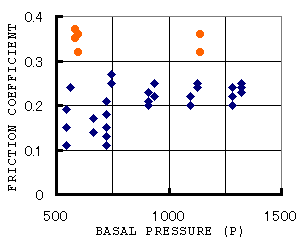|
From slide run results displaying Phase B, the friction coefficients at Phase B
are obtained from the observed deceleration (Fig. 9). The relation
between the friction coefficient and basal pressure (ratio of mass
of disk to basal area) is shown in Fig. 10. The friction
coefficients of the slide without the powder layer are also shown
together for comparison. However, data of a disks having small basal
pressure (< 540 Pa) were excluded due to lack of a clear
boundary between Phases B and C.
|
 |
Fig. 9. Range in
which friction coefficient was obtained. |

Fig. 10. Friction
coefficient versus a basal pressure of the disk.
 |
: on the flour layer |
 |
: without the flour layer |
|
